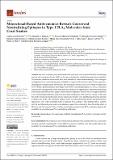Por favor, use este identificador para citar o enlazar a este item:
http://hdl.handle.net/10261/287475COMPARTIR / EXPORTAR:
 SHARE SHARE
 CORE
BASE CORE
BASE
|
|
| Visualizar otros formatos: MARC | Dublin Core | RDF | ORE | MODS | METS | DIDL | DATACITE | |

| Título: | Monoclonal-Based Antivenomics Reveals Conserved Neutralizing Epitopes in Type I PLA2 Molecules from Coral Snakes |
Autor: | Correa-Netto, Carlos; Strauch, Marcelo A.; Monteiro-Machado, Marcos; Teixeira-Araujo, Ricardo; Guzzo Fonseca, Juliana; Leitao-Araujo, Moema; Machado-Alves, Maria Lucia; Sanz, Libia CSIC ORCID; Calvete, Juan J. CSIC ORCID; Melo, Paulo A.; Zingali, Russolina Benedeta | Palabras clave: | Enzymatic activity Monoclonal antibody Myotoxicity Neutralization PLA2 activity Phospholipase A2 |
Fecha de publicación: | ene-2023 | Editor: | Multidisciplinary Digital Publishing Institute | Citación: | Toxins 15(1):15 (2023) | Resumen: | For over a century, polyclonal antibodies have been used to treat snakebite envenoming and are still considered by the WHO as the only scientifically validated treatment for snakebites. Nevertheless, moderate innovations have been introduced to this immunotherapy. New strategies and approaches to understanding how antibodies recognize and neutralize snake toxins represent a challenge for next-generation antivenoms. The neurotoxic activity of Micrurus venom is mainly due to two distinct protein families, three-finger toxins (3FTx) and phospholipases A2 (PLA2). Structural conservation among protein family members may represent an opportunity to generate neutralizing monoclonal antibodies (mAbs) against family-conserved epitopes. In this work, we sought to produce a set of monoclonal antibodies against the most toxic components of M. altirostris venom. To this end, the crude venom was fractionated, and its major toxic proteins were identified and used to generate a panel of five mAbs. The specificity of these mAbs was characterized by ELISA and antivenomics approaches. Two of the generated mAbs recognized PLA2 epitopes. They inhibited PLA2 catalytic activity and showed paraspecific neutralization against the myotoxicity from the lethal effect of Micrurus and Naja venoms' PLA2s. Epitope conservation among venom PLA2 molecules suggests the possibility of generating pan-PLA2 neutralizing antibodies. | Descripción: | 17 páginas, 6 figuras, 2 tablas | Versión del editor: | https://dx.doi.org/10.3390/toxins15010015 | URI: | http://hdl.handle.net/10261/287475 | DOI: | 10.3390/toxins15010015 | E-ISSN: | 2072-6651 |
| Aparece en las colecciones: | (IBV) Artículos |
Ficheros en este ítem:
| Fichero | Descripción | Tamaño | Formato | |
|---|---|---|---|---|
| 2023 Toxins 15-15.pdf | 5,26 MB | Adobe PDF |  Visualizar/Abrir |
CORE Recommender
Page view(s)
21
checked on 07-may-2024
Download(s)
42
checked on 07-may-2024
Google ScholarTM
Check
Altmetric
Altmetric
Este item está licenciado bajo una Licencia Creative Commons

